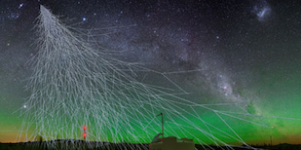CIRCE: Studying ultra-high-energy cosmic rays

Ultra-high-energy cosmic rays are the most energetic particles known, with the highest-energy event ever observed at 3.2x1020 eV, many orders of magnitude above the energy of protons accelerated at e.g. CERN. Their sources and their composition (whether they are made of protons or heavier nuclei) remains a mystery: cosmic rays have to be studied indirectly, through their products of their collisions, and different probes of cosmic ray composition yield contradictory results. Although the most abundant elements in the Universe are Hydrogen and Helium, the products from collisions of the highest-energy cosmic rays with the Earth’s atmosphere appears to be heavy nuclei (nitrogen). These collisions also produce muons abundantly - if taken at face-value, the number of muons reaching the Earth indicate that the original cosmic rays could be heavier even than iron. All these conjectures are based on extrapolations of the standard model of particle physics to energies higher than those where it has been tested on laboratories and accelerators here on Earth. There are only two possible explanations for these contradictory observations: either very interesting, fine-tuned astrophysics; or, new physics at trans-LHC energies making protons’ interactions have a ”heavy nuclei” footprint.
The purpose of project CIRCE (named after the sister of Minoan Queen Pasiphae), which is led by Prof. V. Pavlidou and funded by the HFRI, is to extensively study the problem from both perspectives: astrophysical accelerators of cosmic rays that could naturally produce the peculiar composition observed at Earth, and possible new physics that could affect our interpretation of collected data. In our studies we use simulations of cosmic ray acceleration, propagation in the Universe, and collisions in the Earth’s atmosphere.
